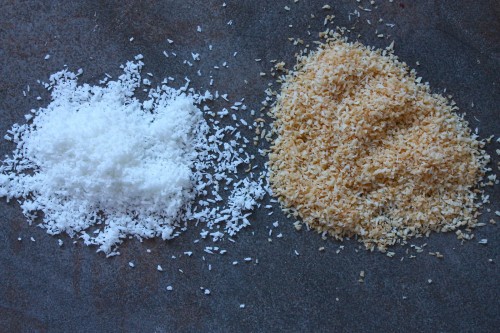Desiccated coconut flakes (unsweetened) like this isn’t normally used in Thai cuisine; it’s used mostly in the cuisines of South Asia and the Middle East. It’s so easy to find. In fact, I’ve never found any South Asian (Indian, Pakistani, etc.) grocery store in the US that doesn’t have this ingredient.
However, I recommend it for certain Thai dishes that call for thinly-sliced or finely-julienned mature coconut meat, toasted, as it saves you time and reduces your workload. To produce julienned coconut meat means that you have to crack a mature coconut, remove the meat from the shell, and slice it manually (a food processor is useless for this task). Based on my experience, this is hellish and takes a long time. You can certainly go that route. Otherwise, desiccated coconut flakes are a good compromise.
Being desiccated means this type of coconut won’t produce coconut milk. You could soak the flakes in warm water, but only a thin, insipid, useless coconut-flavored liquid is all you’re going to get. To make coconut milk, you need either fresh or frozen grated mature coconut meatwhich has never been desiccated. To grate coconut yourself, you need a coconut rabbit. Otherwise, frozen grated coconut meat (from either the Philippines or Thailand) in the freezer section of your local Southeast Asian store is your friend.
To toast desiccated coconut flakes, put the flakes in a dry skillet over medium-low heat and stir almost constantly until the coconut flakes turn dark blond (or is it light brown?). Do not walk away from the skillet even for just a bit as the flakes go from light brown to black in a matter of seconds. This task doesn’t take that much time anyway.











